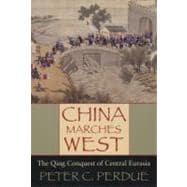
What is included with this book?
| Preface | |
| Acknowledgments | |
| Note on Names, Dates, Weights and Measures, and Chinese Characters | |
| Introduction | |
| History, Time, and Memory | |
| The Qing Conquests as a World Historical Event | |
| The Formation of the Central Eurasian States | |
| Environments, State Building, and National Identity | |
| The Unboundedness of Central Eurasia | |
| Trade, Transport, and Travel | |
| The Frontier | |
| Zone | |
| Isolation and Integration | |
| The Ming, Muscovy, and Siberia, 1400-1600 | |
| The Ming and the Mongols | |
| State Formation in Muscovy and Russian Expansion | |
| Siberian and Chinese Frontiers | |
| Central Eurasian Interactions and the Rise of the Manchus, 1600-1670 | |
| Building the Zunghar State | |
| The Rise of the Manchus Mongolian Influence on the Manchu State | |
| Early Modern State Building Compared | |
| Contending for Power | |
| Manchus, Mongols, and Russians in Conflict, 1670-1690 | |
| Kangxi the Ruler Galdan's Intervention | |
| Kangxi's First Personal Expedition | |
| The Treaty of Nerchinsk and the Excluded Middle | |
| Eating Snow: The End of Galdan, 1690-1697 | |
| The Dolon Nor Assembly | |
| The Battle of Jao Modo | |
| The Emperor Rewrites History | |
| The Final Campaigns and the Fate of Galdan | |
| Imperial Overreach and Zunghar Survival, 1700-1731 | |
| The Rise of Tsewang Rabdan | |
| Three Central Eurasian Travelers | |
| The Penetration of Turkestan and Tibet | |
| The New Emperor Changes Tack | |
| The Final Blows, 1734-1771 Transforming the Barbarians through Trade | |
| The Death Knell of the Zunghar State | |
| The Conquest of Turkestan | |
| The Return of the Torghuts | |
| The Economic Basis of Power | |
| Cannons on Camelback: Ecological Structures and Economic Conjunctures | |
| Galdan the State Builder | |
| Nian Gengyao and the Incorporation of Qinghai | |
| Administering the Frontier | |
| Land Settlement and Military | |
| Colonies Deportation from Turfan | |
| Settlement of Xinjiang | |
| Colonization and Land | |
| Clearance Economic Development | |
| Harvests and Relief | |
| Harvests and Yields | |
| Granary Reserves | |
| The Contribution Scandal | |
| The Relief Campaign of 1756 | |
| Currency and Commerce | |
| Money on the Frontier, from Song through Ming | |
| Integration and Stabilization | |
| Commerce as a Weapon of War | |
| Tribute and Frontier Trade | |
| Fixing Frontiers | |
| Moving through the Land | |
| Travel and Authority | |
| Marking Space in Stone | |
| Maps and Power | |
| Expanding the Imperial Gaze | |
| Marking Time: Writing Imperial History | |
| Kangxi's Campaign History | |
| Yongzheng and the Dayi | |
| Juemilu Qianlong's Account of the Zunghar Mongols | |
| A View from the Frontier | |
| Nomadic Chronicles | |
| Legacies and Implications | |
| Writing the National History of Conquest | |
| Statecraft Writers and Empire | |
| Geopolitics and Emperor Worship | |
| Chinese Historians and the Multicultural State | |
| Soviet and Mongolian Attacks on Qing Aggression | |
| Empires, Nations, and Peoples | |
| State Building in Europe and Asia | |
| The Political Ecology of Frontier Conquest | |
| European, Chinese, and Inner Asian Models | |
| Theories of Nomadic Empires | |
| Rethinking the Qing in the World | |
| Frontier Expansion in the Rise and Fall of the Qing | |
| The End of the Qing State | |
| Northwest and Southern Frontiers | |
| The Negotiated State | |
| Commercialization and Regionalization | |
| Appendixes | |
| Rulers and Reigns | |
| The Yongzheng Emperor Reels from the News of the Disaster, 1731 | |
| Haggling at the Border | |
| Gansu Harvests and Yields | |
| Climate and Harvests in the Northwest | |
| Abbreviations | |
| Notes | |
| Bibliography | |
| Illustration | |
| Credits | |
| Index | |
| Table of Contents provided by Publisher. All Rights Reserved. |
The New copy of this book will include any supplemental materials advertised. Please check the title of the book to determine if it should include any access cards, study guides, lab manuals, CDs, etc.
The Used, Rental and eBook copies of this book are not guaranteed to include any supplemental materials. Typically, only the book itself is included. This is true even if the title states it includes any access cards, study guides, lab manuals, CDs, etc.